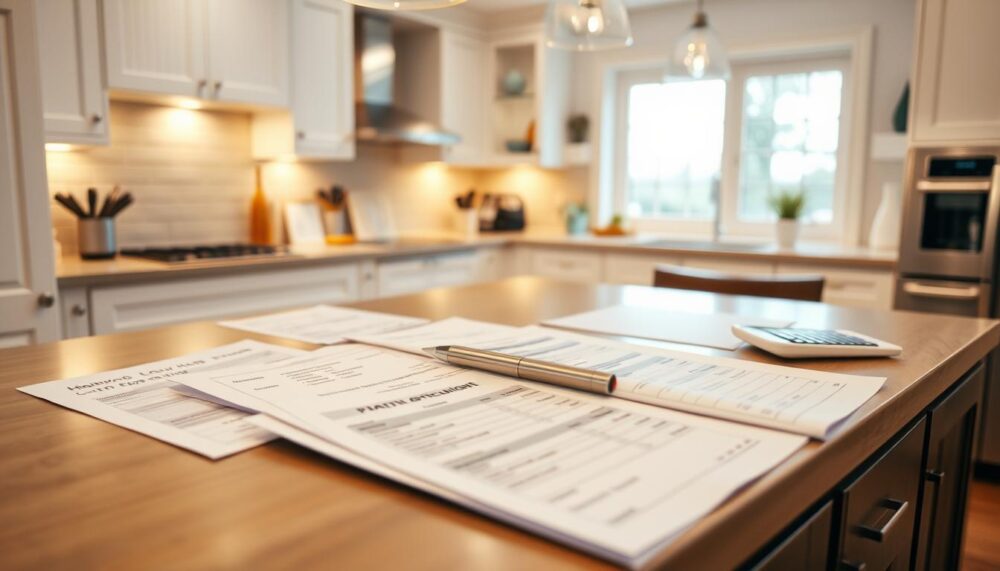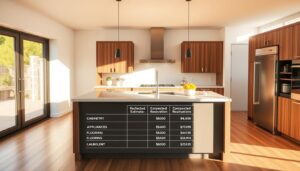Embarking on a kitchen remodel is an exciting project for many homeowners. A well-planned upgrade can transform your home’s heart. Yet, the costs involved require careful financial planning.
Choosing the right funding method makes all the difference. It ensures your dream space becomes reality without straining your budget. Various financing options exist to suit different needs and circumstances.
From personal loans to leveraging home equity, each choice has unique benefits. Interest rates, repayment terms, and credit requirements vary widely. Understanding these helps you select the most cost-effective solution.
This guide explores UK-specific programmes and lending products. We focus on practical advice to help you make informed decisions. Let’s examine the best ways to fund your kitchen transformation.
Key Takeaways
- Proper financial planning is crucial for a successful kitchen upgrade project.
- Multiple funding options exist, including personal loans and home equity solutions.
- Interest rates and repayment terms vary significantly between different loan products.
- Your personal circumstances should guide your choice of financing method.
- UK homeowners have access to specific programmes and lending options.
- Understanding costs and repayment structures helps maintain your budget.
- Informed decisions lead to more manageable monthly payments and overall costs.
Introduction to Kitchen Renovation Financing
Transforming your cooking space represents one of the most valuable home improvements you can undertake. While exciting, these projects often come with substantial price tags that make upfront cash payments challenging for many households.
Research indicates even modest updates average around £20,000, with comprehensive transformations frequently exceeding £100,000. These figures explain why most families seek alternative payment methods rather than draining their savings accounts.
Spreading costs through various credit arrangements makes ambitious projects achievable. Rather than compromising on quality or settling for partial updates, financing enables complete transformations that truly enhance your home’s functionality and value.
“The kitchen serves as the heart of the home, and investing in its improvement often yields both practical benefits and emotional satisfaction.”
Thoughtful financial planning remains crucial for several reasons:
- Preserves emergency funds for unexpected circumstances
- Allows inclusion of premium features within comfortable repayment terms
- Maintains monthly budget stability while achieving renovation goals
- Enables professional installation rather than DIY compromises
Whether dreaming of custom cabinetry, premium appliances, or improved layouts, appropriate funding solutions make these aspirations attainable. The key lies in matching your project scope with repayment structures that align with your financial situation.
Upcoming sections explore specific lending products and programmes available to UK homeowners. Understanding these alternatives empowers you to make informed decisions about creating your ideal cooking space without financial strain.
Understanding the Cost of a Kitchen Renovation
Before exploring funding solutions, it’s essential to grasp what your cooking space transformation might actually cost. The final amount varies dramatically based on your vision and choices.
Establishing a realistic budget early prevents financial surprises later. This clarity helps you select appropriate funding methods that match your project’s scope.
Average Cost Ranges for UK Kitchen Projects
British homeowners typically encounter three primary investment tiers for their cooking space updates. Each level offers different value and transformation depth.
Small cosmetic refreshes usually fall between £8,000 and £16,000. These often involve repainting existing cabinets or installing new work surfaces without structural changes.
Mid-range transformations range from £24,000 to £40,000. This investment typically includes completely new cabinetry, modern appliances, and updated lighting fixtures.
High-end luxury projects frequently exceed £60,000. These comprehensive overhauls feature bespoke designs, premium materials, and professional installation services.
Key Factors Influencing Your Final Budget
Several elements significantly impact your overall expenditure. Understanding these helps allocate funds wisely.
The room’s dimensions directly affect material and labour costs. Larger spaces naturally require more cabinetry, flooring, and installation time.
Structural modifications versus surface updates present different financial considerations. Moving walls or plumbing involves additional professional services and permissions.
Material selections create substantial cost variations. Granite worktops versus laminate, or custom-built versus standard cabinets, represent different investment levels.
Regional labour rates across Britain show noticeable differences. London-based tradespeople often charge higher rates than those in other regions.
Always include a 10-20% contingency fund for unexpected discoveries. Older properties might reveal wiring issues or structural concerns once work begins.
Your choices dramatically influence the final amount required. Premium appliances or handmade tiles might elevate your project into a higher cost bracket.
Evaluating Your Financial Health Before You Borrow
Securing funds for home improvements requires careful financial assessment beforehand. Understanding your current money situation helps avoid future stress.
Review your existing debt obligations before considering new loans. This includes credit card balances, car payments, and other monthly commitments.
Your credit score plays a crucial role in securing favourable terms. Lenders use this number to assess risk and determine interest rates.
Calculate your debt-to-income ratio to understand borrowing capacity. This simple formula divides monthly debt payments by gross monthly income.
Most lenders prefer ratios below 36% for approval. Higher ratios might limit your options or increase borrowing costs.
Consider your savings situation alongside renovation plans. Maintaining emergency funds ensures unexpected expenses don’t derail your budget.
Future financial goals deserve equal consideration. Will monthly payments affect other important life plans?
Different credit scores open different financing doors. Excellent scores typically secure lower rates and better terms.
Practical steps can improve your financial health before applying:
- Check your credit report for errors
- Pay down existing credit card balances
- Avoid new credit applications beforehand
- Gather necessary documentation early
Calculate affordable monthly payment amounts based on your budget. Use online calculators to test different scenarios.
Remember that borrowing decisions have long-term implications. Choose repayment terms that align with your overall financial strategy.
For detailed guidance on assessing your financial readiness, explore our comprehensive resource on kitchen remodel financing preparation.
Taking time to evaluate these factors ensures your project enhances your home without compromising financial stability. Smart planning today prevents repayment challenges tomorrow.
How to Finance a Kitchen Renovation with a Personal Loan
Personal loans offer a straightforward approach to funding home improvements. These unsecured options provide immediate access to money without using your property as security.
Borrowers receive a lump sum upfront. This makes budgeting for materials and labour much simpler. You’ll repay through fixed monthly payments over an agreed period.
Advantages and Disadvantages of Personal Borrowing
These loans bring several benefits to your project. The absence of collateral requirements stands out as a major advantage. Your home remains protected regardless of repayment circumstances.
Funding speed represents another significant benefit. Many lenders transfer funds within days of approval. Some even offer same-day processing for urgent needs.
Fixed repayment amounts help with financial planning. You’ll know exactly what to budget each month. This predictability prevents unexpected payment increases.
However, certain drawbacks deserve consideration. Interest rates typically run higher than secured alternatives. This increases the total amount you’ll repay over time.
Tax benefits available with home equity options don’t apply here. You cannot deduct interest payments from your tax obligations.
The borrowed amount remains fixed once approved. Additional funds require a completely new application process.
“Personal loans provide immediate financial flexibility without putting your home at risk, making them ideal for well-budgeted improvement projects.”
Securing Your Loan: A Step-by-Step Guide
Begin by obtaining detailed cost estimates from contractors. This determines the exact loan amount you need to request.
Pre-qualification helps understand your borrowing options. Multiple lenders offer this service without affecting your credit score.
Comparison shopping proves essential for finding the best deal. Consider both interest rates and repayment terms when evaluating offers.
| Lender Type | Typical Rates | Funding Time | Maximum Amount |
|---|---|---|---|
| High Street Banks | 6%-15% | 3-5 business days | £50,000 |
| Online Lenders | 7%-36% | 1-2 business days | £100,000 |
| Credit Unions | 5%-18% | 2-4 business days | £75,000 |
Prepare necessary documentation before applying. Lenders typically require proof of income, employment verification, and bank statements.
The application process involves submitting your details for formal approval. Once approved, funds usually arrive within a week.
Careful planning ensures you secure the best possible terms for your circumstances. Take time to compare multiple offers before committing.
Leveraging Your Home’s Equity: Home Equity Loans
Homeowners with substantial property value often access funds through their home’s worth. This approach provides significant borrowing power for major projects.
Equity represents the portion of your property you truly own. It’s the difference between market value and outstanding mortgage debt.
These financial products function as second mortgages secured against your property. They offer lump sums with structured repayment plans.
How a Home Equity Loan Works
Lenders calculate your available equity before approving any amount. They typically allow borrowing up to 85% of your home’s value minus existing mortgage debt.
Your credit history and income still play important roles. However, the secured nature often means more flexible requirements.
Repayment terms extend up to 30 years with fixed monthly payments. This provides long-term budget predictability for homeowners.
Interest rates generally start in single digits. They’re typically lower than unsecured alternatives due to the collateral involved.
“Home equity loans transform your property’s value into accessible funds for substantial improvements.”
Several advantages make this option appealing for larger projects:
- Substantial borrowing amounts based on your property’s worth
- Fixed interest rates throughout the repayment period
- Potential tax benefits on interest payments
- Longer repayment terms than personal loans
However, using your home as collateral carries inherent risks. Defaulting on payments could lead to foreclosure proceedings.
The application process involves property valuation and credit checks. Funding typically takes slightly longer than unsecured options.
Comparing Home Equity Loans to Personal Loans
These two borrowing methods serve different financial situations. Your choice depends on amount needed and risk tolerance.
Home equity options generally offer larger amounts at better rates. They’re ideal for comprehensive projects requiring significant investment.
Personal loans work better for smaller, quicker projects. They don’t put your property at risk but cost more in interest.
| Feature | Home Equity Loan | Personal Loan |
|---|---|---|
| Maximum Amount | Up to 85% of home value | Typically £50,000 |
| Interest Rates | 5%-8% | 6%-15% |
| Repayment Term | 5-30 years | 1-7 years |
| Collateral Required | Yes | No |
| Funding Time | 2-4 weeks | 1-3 days |
Home equity financing suits homeowners with significant property value. It’s particularly useful when needing more than personal loans allow.
Consider this option if you have built substantial equity. It provides cost-effective funding for major transformations.
Always consult financial advisors before committing. They help assess whether this solution matches your circumstances.
Flexible Borrowing: Home Equity Lines of Credit (HELOCs)
Many property owners discover that revolving credit facilities offer remarkable adaptability for major home upgrades. A home equity line of credit represents a dynamic approach to accessing your property’s worth.
Unlike traditional loans that provide a single lump sum, this arrangement establishes a credit limit. You may draw funds as required during the established period. This flexibility proves invaluable for ongoing projects.
Understanding HELOC Draw and Repayment Periods
These credit arrangements typically feature two distinct phases. The initial draw period usually spans ten years. During this time, you may access funds up to your approved limit.
Borrowers often make interest-only payments during the draw phase. This keeps initial monthly payments manageable. The repayment period follows, typically lasting twenty years.
During repayment, you’ll settle both principal and interest. Your monthly payments will increase accordingly. This structure provides long-term financial planning certainty.
When a HELOC is the Right Choice for Your Project
Variable interest rates characterise these credit lines. While starting rates are often attractive, they may fluctuate over time. This creates potential payment variations throughout your loan term.
The revolving nature offers distinct advantages for renovation work. You borrow precisely what you need when expenses arise. This prevents paying interest on unused funds.
“A HELOC provides financial flexibility that fixed-amount loans cannot match, making it ideal for projects with evolving requirements.”
This option shines particularly for projects with uncertain final costs. Unexpected expenses often emerge during property upgrades. Having available credit prevents budget shortfalls.
Compared to personal loans, HELOCs offer superior adaptability. With standard loans, you cannot access additional money without reapplying. This credit line remains available throughout your draw period.
Consider these scenarios where a HELOC proves advantageous:
- Multi-phase projects with staggered funding requirements
- Renovations where final costs are difficult to predict
- Homeowners wanting preparedness for unexpected expenses
- Property upgrades that might expand beyond initial plans
Variable rate financing requires careful risk assessment. Interest rate increases could raise your monthly payments substantially. Ensure your budget can accommodate potential payment fluctuations.
Effective management of your draws ensures financial control:
- Track all withdrawals against your project budget
- Monitor interest rate changes throughout your draw period
- Consider making principal payments during the draw phase
- Review your outstanding balance regularly
| Feature | HELOC | Personal Loan |
|---|---|---|
| Funds Access | As needed during draw period | Single lump sum |
| Interest Type | Typically variable | Usually fixed |
| Payment Flexibility | Interest-only during draw period | Fixed monthly payments |
| Additional Funds | Available without reapplying | Requires new application |
| Best For | Uncertain project costs | Fixed-budget projects |
This borrowing method suits homeowners comfortable with variable rates. It offers unparalleled flexibility for substantial property improvements. Carefully consider whether this matches your financial temperament and project needs.
Cash-Out Refinance: Combining Your Mortgage and Renovation Costs
Some homeowners discover an effective method to fund major upgrades through their existing mortgage arrangement. This approach merges your property financing with improvement costs into one manageable payment.
Cash-out refinancing replaces your current home loan with a new, larger mortgage. The extra money beyond your existing balance becomes available for your project. This creates a single monthly payment covering both your property debt and renovation expenses.
Is Refinancing a Financially Sound Decision?
This option works best when market conditions favour lower interest rates. Securing a reduced rate makes the financial mathematics work in your favour. The savings from lower payments should outweigh the refinancing costs.
Closing costs represent an important consideration in this process. These fees typically range between 2-5% of your loan amount. They include valuation charges, legal fees, and administrative expenses.
Financial planners recommend conducting a break-even analysis beforehand. Calculate how many months of lower payments it takes to recover your closing costs. This determines whether refinancing makes sense for your situation.
“Cash-out refinancing can be a powerful tool when interest rates have dropped significantly since you obtained your original mortgage.”
Several scenarios make this approach particularly advantageous:
- When current mortgage rates sit well below your existing rate
- For homeowners planning to stay in their property long-term
- When needing substantial funds for comprehensive upgrades
- For borrowers preferring one monthly payment instead of multiple loans
The long-term nature of mortgage financing spreads costs over many years. This creates manageable monthly payments for substantial projects. However, it also means paying interest on your improvement costs for decades.
Increasing your overall mortgage debt requires careful consideration. While spreading payments, you’re essentially borrowing against your property’s future value. Ensure your upgrades genuinely enhance your home’s worth.
Calculating the true cost involves more than just comparing interest rates. Consider the total interest paid over the loan’s lifetime. Factor in closing costs and potential early repayment charges.
Comparison against other methods reveals distinct advantages and drawbacks:
| Consideration | Cash-Out Refinance | Home Equity Loan |
|---|---|---|
| Interest Rate | First mortgage rate | Typically higher than first mortgage |
| Closing Costs | 2-5% of loan amount | 1-3% of loan amount |
| Repayment Term | 15-30 years | 5-20 years |
| Monthly Payments | Single combined payment | Additional monthly payment |
| Best For | Lower rates + major projects | Keeping existing low mortgage rate |
This financing method suits homeowners with considerable equity and favourable rate conditions. It provides substantial funds while potentially reducing your overall interest burden. Always consult mortgage advisors to determine if this solution matches your financial circumstances.
Government and Energy-Efficient Programmes
Homeowners seeking funding solutions may find government-backed options particularly appealing. These programmes often provide attractive terms for qualifying individuals.
Two notable schemes deserve special attention for property upgrades. They offer unique benefits that traditional lending products cannot match.
FHA Title I Property Improvement Loans
The Federal Housing Administration supports borrowing for home enhancements through this scheme. It enables property owners to access necessary funds for various upgrades.
This loan option works beautifully for kitchen transformations. Borrowers can secure amounts up to £25,000 for single-family homes.
An important requirement applies to larger projects. Any loan exceeding £7,500 must be secured against your property through a deed of trust.
Several advantages make this programme stand out:
- Competitive interest rates compared to conventional personal loans
- Flexible credit requirements for borrowers with less-than-perfect scores
- Long repayment terms extending up to twenty years
- Fixed monthly payments for predictable budgeting
Your kitchen project might qualify if it improves functionality or efficiency. Cabinet replacements, appliance upgrades, and layout changes typically meet programme criteria.
Energy Efficient Mortgage Programme
Environmentally conscious homeowners have exciting financing opportunities. This programme specifically supports eco-friendly home improvements.
The scheme allows borrowers to include energy-saving upgrades in their mortgage. This approach spreads the project cost over the loan’s lifetime.
Qualifying improvements must demonstrate measurable energy reduction. The programme focuses on upgrades that lower utility consumption and bills.
“Energy-efficient mortgages recognise that saving energy saves money, creating a win-win situation for homeowners and the environment.”
Kitchen enhancements that might qualify include:
- Energy Star rated appliances
- Improved insulation around windows and doors
- LED lighting systems throughout the space
- Water-efficient fixtures and fittings
Homeowners enjoy dual benefits from these upgrades. They reduce monthly utility expenses while increasing property value.
The application process involves energy assessment documentation. Certified professionals must verify the projected energy savings.
Government-backed options suit borrowers seeking favourable terms. They often feature lower interest rates and more flexible approval criteria.
Consider these programmes if your credit history presents challenges. They might offer better opportunities than conventional lenders.
Always consult programme guidelines before applying. Ensure your planned improvements meet specific qualification requirements.
These schemes make environmentally friendly upgrades more accessible. They support homeowners in creating sustainable, efficient living spaces.
Other Financing Avenues: Contractor Plans and Credit
Alternative funding methods exist beyond traditional lending institutions. These approaches offer unique advantages for specific situations.
Many renovation firms provide their own financial arrangements. These programmes simplify the funding process for homeowners.
Contractor financing typically involves partnerships with specialist lenders. Some companies operate their own in-house credit schemes.
The convenience factor stands out as a major benefit. You can arrange both your project and funding simultaneously.
This bundling approach saves significant time and effort. However, comparing terms remains absolutely essential.
“While contractor financing offers convenience, always compare their terms with other available options to ensure you’re getting the best deal.”
Interest rates might be higher than standard personal loans. The convenience sometimes comes at a premium cost.
Credit cards represent another flexible funding tool. They work particularly well for smaller purchases.
Strategic use of plastic can be quite effective. Many cards offer introductory 0% APR periods.
These promotional rates provide interest-free borrowing. They’re perfect for short-term financing needs.
However, standard rates apply once promotions expire. These can be considerably higher than other options.
The temptation to overspend requires careful management. It’s easy to accumulate substantial debt quickly.
| Financing Method | Best For | Typical Amount | Interest Rate Range |
|---|---|---|---|
| Contractor Financing | Convenience seekers | £5,000-£50,000 | 8%-20% |
| Credit Cards | Small purchases | Up to credit limit | 0% intro, then 15%-25% |
| Store Cards | Specific appliances | £500-£10,000 | 0% intro, then 20%-30% |
Contractor arrangements suit homeowners valuing simplicity. They eliminate multiple application processes.
Credit options work best for specific component purchases. Think premium appliances or custom cabinetry.
Always negotiate terms before committing. Many contractors offer flexible repayment structures.
Consider these funding methods for well-defined projects. They provide targeted financial solutions.
Remember that larger transformations might need more substantial funding. These options have natural limitations.
Your choice should align with your overall budget strategy. Ensure monthly payments remain manageable.
A Practical Guide to Choosing the Right Option for You
Selecting the ideal funding method requires careful evaluation of your unique circumstances. Each financing solution presents distinct advantages and considerations that merit thorough examination.
Your decision should balance immediate needs with long-term financial health. A systematic approach ensures you find the most suitable arrangement for your project.
Comparing Interest Rates and Total Loan Cost
Interest rates significantly impact your overall repayment amount. Even small percentage differences accumulate substantially over time.
Always look beyond advertised rates to understand the true cost. Factor in arrangement fees, early repayment charges, and any hidden costs.
Fixed rates provide payment certainty throughout your term. Variable options might offer lower initial rates but carry future uncertainty.
“The cheapest monthly payment doesn’t always mean the best deal – always calculate the total amount you’ll repay over the full term.”
Consider this comparison between common financing methods:
| Financing Type | Typical Interest Rate | Average Total Cost* |
|---|---|---|
| Personal Loan | 7.9% | £28,500 |
| Home Equity Loan | 5.2% | £26,800 |
| HELOC | 4.8% (variable) | £25,900 |
*Based on £20,000 borrowed over 5 years
Online calculators help visualise different scenarios. Input your loan amount, term length, and interest rate to see total costs.
Assessing Loan Terms and Monthly Affordability
Monthly payments must align with your budget constraints. Longer terms reduce monthly amounts but increase total interest paid.
Shorter repayment periods save money overall but require higher monthly commitments. Find the balance that works for your situation.
Consider your expected home ownership duration when choosing terms. There’s little benefit in a 15-year loan if you plan to move in 5 years.
Evaluate these key affordability factors:
- Current monthly income and expenses
- Future financial goals and obligations
- Potential changes to employment status
- Other existing debt commitments
Fees and closing costs deserve equal consideration. Some options charge substantial arrangement fees that add to your total cost.
Home equity products typically involve valuation and legal fees. Personal loans might have arrangement charges but usually no security costs.
Prioritise options based on your individual circumstances. Those with excellent credit might prefer unsecured personal loans. Homeowners with substantial equity could benefit from secured options.
Always request full cost breakdowns from potential lenders. Compare these carefully before making your final decision.
Smart Planning: Tips for a Financially Successful Renovation
Achieving your dream cooking space requires thoughtful financial preparation alongside creative vision. Smart budgeting transforms ambitious ideas into achievable realities while protecting your financial wellbeing.
Always allocate extra funds for unexpected discoveries. Hidden issues often emerge once work begins, from outdated wiring to structural surprises. A 15-20% contingency cushion prevents stressful budget overruns.
Prioritise elements based on your primary goals and available money. If creating more space is your main objective, focus resources on structural changes rather than premium cabinets. This strategic approach maximises impact within your budget constraints.
Consider future property sale potential if moving within five years. Balance personal preferences with features that appeal to prospective buyers. Neutral colour schemes and quality fittings often deliver better returns than highly personalised choices.
“The most successful renovations blend personal enjoyment with smart financial decisions that protect your investment.”
Working with contractors requires clear budget discussions from the outset. Request detailed quotes breaking down labour, materials, and timeline estimates. This transparency helps identify potential savings opportunities.
Obtain multiple quotations before committing to any professional. Price variations can be significant between different firms. Comparing offers ensures you receive fair value for your project investment.
Phasing your project helps manage cash flow effectively. Complete essential structural work first, then add cosmetic enhancements later. This approach spreads costs while maintaining progress.
Common budget pitfalls include underestimating professional fees and permit costs. Always include these in your initial calculations. Unexpected delivery charges for materials can also create surprises.
Maximise value by focusing on high-impact, cost-effective upgrades. Quality work surfaces and efficient lighting often deliver better returns than expensive appliance packages. Smart choices create luxury impressions without luxury price tags.
Monitor your financing arrangements throughout the project duration. Some credit options allow additional draws if needed, while others remain fixed. Understanding your flexibility prevents funding shortfalls.
Align your repayment schedule with the project timeline. Ensure funds are available when needed without paying interest prematurely. This coordination optimises your money management throughout the process.
Remember that quality craftsmanship often justifies higher initial costs. Skilled professionals complete work efficiently and to higher standards. This saves money on future repairs and enhances long-term value.
Your dream space awaits through careful planning and smart financial decisions. These strategies help create a beautiful, functional area that respects your budget boundaries.
Conclusion
Your dream cooking space awaits with the right funding approach. From personal loans to home equity solutions, various paths exist to fund your project wisely.
Matching your financial situation with the ideal option ensures manageable repayments. Smart planning protects your budget while achieving stunning results.
Remember that careful consideration of loan terms and total cost matters most. Your ideal space becomes reality through informed decisions.
Take that first step toward your beautiful new kitchen today. With proper preparation, you’ll enjoy both the transformation and financial peace of mind.
FAQ
What are the most common ways to fund a kitchen renovation in the UK?
Popular options include personal loans, home equity loans, and HELOCs. Many homeowners also use savings or consider credit cards for smaller updates. Each choice has its own benefits and considerations.
Is a personal loan a good option for remodelling a kitchen?
A personal loan can be a great choice if you need funds quickly and don’t want to use your home as security. They often have fixed interest rates and set repayment terms, making budgeting straightforward.
How does a home equity loan work for a kitchen project?
A home equity loan allows you to borrow against the value you’ve built up in your property. You receive a lump sum with a fixed interest rate, which you repay over time. It’s useful for larger renovations.
What is a HELOC and when should I consider one?
A Home Equity Line of Credit works like a flexible credit card tied to your home’s equity. It’s ideal if your project has variable costs or you’re unsure of the final amount needed. You only pay interest on what you use.
Are there government schemes available for kitchen upgrades?
While direct grants are rare, some energy-efficient improvements might qualify for specific programmes. It’s always worth checking local council offers or green initiatives that could reduce overall costs.
How can I keep my monthly payments affordable?
A> Focus on finding a loan with competitive interest rates and a term that fits your budget. Always use a loan calculator to test different scenarios before committing. Sticking to a realistic budget helps too.






